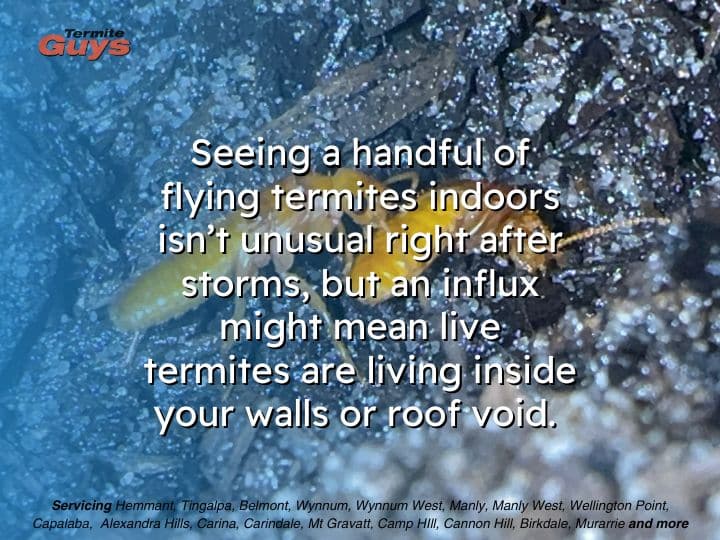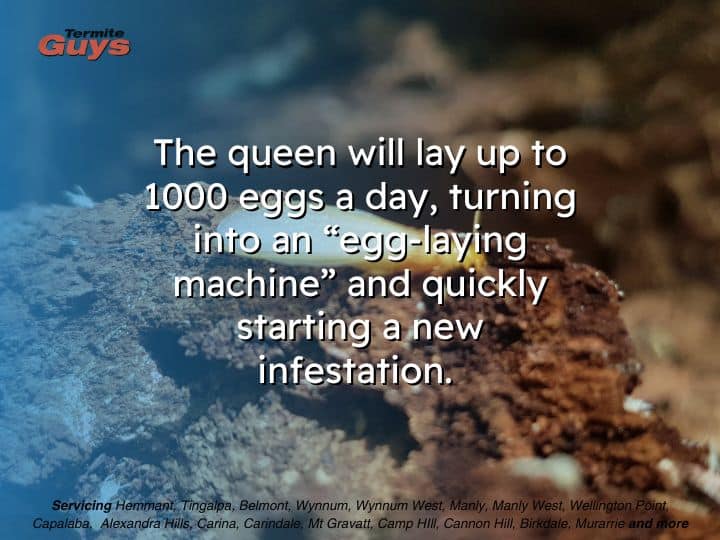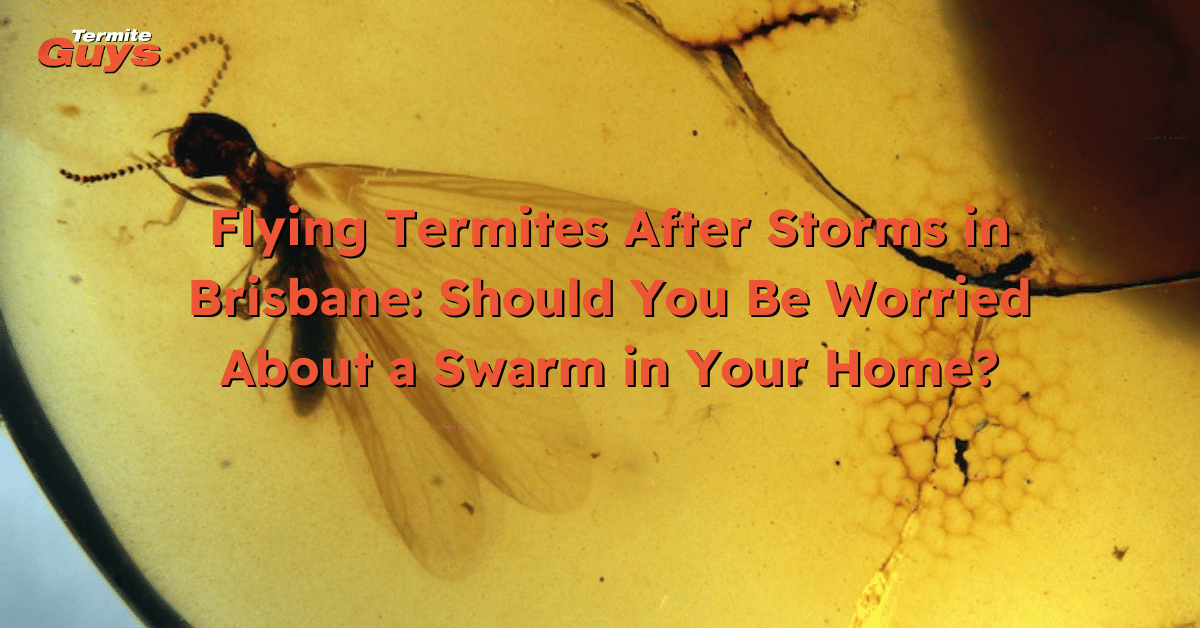Should You Be Worried About a Swarm in Your Home?
Flying termites swarming after a Brisbane storm is more than a curious event – it’s often the warning sign of an active or looming infestation. Brisbane’s unique blend of heat and humidity means storms provide ideal conditions for these pests to swarm, search for new homes, and start destroying unsuspecting properties. When you see flying termites after a storm, it’s not just rainwater you need to worry about. These winged invaders could be a sign of live, active termites nearby, or even worse – a hidden nest within your walls.
If you see termites swarming in Brisbane during October or November, it’s a serious warning sign that a nest is nearby. Flying termites are nature’s way of telling you your home could soon be at risk. The best prevention is installing a professional termite barrier to keep them out. That’s why calling Termite Guys Brisbane is so important. Don’t wait until damage occurs—act now. Call 07-3393-3515 or email admin@termiteguys.com.au
Here’s what every Brisbane homeowner must know to protect their property:
Swarms of flying termites signal heightened termite risk after storms in Brisbane.
These events may mean termites are already inside your home, or ready to invade.
Professional inspection and up-to-date termite barriers are critical for home protection.
Why Do Flying Termites Appear After Storms in Brisbane?
Storms create the perfect environment for termite swarms. The sudden boost in moisture, increased humidity, and softened ground all encourage these insects – known as alates – to start their colonising flight. They’re not looking for a temporary spot; they want to become the new kings and queens of hidden colonies in Brisbane timber, stumps, and even homes.
Heavy rain and humidity trigger termite swarming seasons, especially from October to March.
After storms, flying termites shed their wings and pair up to found new colonies.
Spotting alates often means a mature termite colony is nearby.
Questions clients ask
Why do I see flying termites after Brisbane storms?
Flying termites swarm after storms because rain and humidity signal the best time to establish new colonies. The softened soil and moist timber around homes are irresistible to termite queens searching for a nest.
Are flying termites a sign of an infestation in Brisbane?
If you see flying termites—especially in large numbers inside—there’s a real chance that your property is already hosting an active colony. Swarming is often the visible clue of termites that have been hidden and destructive for months.
Do Swarms of Flying Termites Mean I Have Live (Active) Termites?
Seeing a handful of flying termites indoors isn’t unusual right after storms, but an influx might mean live termites are living inside your walls or roof void. Swarmers entering through gaps is common, but termites coming out directly from the wall—sometimes called “flight tubes” – means active infestation.
Abundant flying termites emerging inside can indicate an established nest within the property.
Live termites chew through timber and can cause deep structural damage before being noticed.
Homes with damp areas post-storm are particularly attractive to nest-building queens

What to be aware of during swarming season:
Flying termites frequently target bathrooms, ceiling vents, and cool, damp corners.
Live termites cause hollow-sounding timber, mud tubes, and visible holes.
Brisbane’s climate puts all homes – ld and new – at risk after every major weather event.
An indoor swarm suggests a hidden nest is already active or maturing.
Swarmers from the wall need expert termite control immediately.
Questions homeowners ask us
What does it mean if termites are coming out of the wall?
If termites are flying directly out of a wall, it usually signals a mature nest has developed inside—often requiring urgent treatment and barrier installation to avoid major timber damage.
How do I know if my termite barrier is compromised?
Barriers may fail after storms if soil shifts, moisture erodes the chemical, or untreated dirt bridges the protective zone. Regular professional checks ensure your home remains protected.
How Can Brisbane Homeowners Stop Flying Termites After Storms?
Stopping flying termites and preventing a swarm from founding a new colony demands quick, precise action. The first step is to close entry points and eliminate indoor lights that attract swarmers. Next, contact professionals for a thorough inspection and a quote for installing or renewing chemical or physical barriers.
Tips to stop flying termites:
Shut all windows, doors, and fix screens to halt termite entry.
Turn off outdoor lights during swarm season—flying termites are drawn to them.
Avoid DIY sprays as they can drive termites further into hiding.
Book a professional on-site quote for barrier installation or repairs.
Only approved, professional-grade barriers offer long-term protection in Brisbane’s climate.
How to be prepared when swarming starts:
Professional pest experts use thermal and moisture detection for the most accurate inspections.
Modern chemical barriers like Termidor last up to 8 years in Brisbane and work best when regularly checked.
Old or damaged barriers after storms should be re-treated.
Get a detailed on-site quote for the cost of new barriers from termite specialists.
Routine checks and rapid repairs keep your home’s defenses strong.
Combining physical and chemical barriers is recommended for the best results.
What you should know about termite activity around storm season
How much does a termite barrier quote cost in Brisbane?
Brisbane termite professionals typically offer free or low-cost on-site barrier quotes, assessing your home and providing a personalised solution to suit local risk factors.
What do people call us about
What’s the fastest way to keep flying termites out after storms?
Immediately close all entry points, reduce indoor lighting, and call a trusted termite inspector to check your barriers. Rapid response prevents new colonies from taking hold.
What Happens During a Termite Swarm? How Are Colonies Founded?
Termite swarms are short, chaotic flights triggered by a drop in air pressure after storms. Alates pair off, land, shed their wings, and head for timber or soil – often tree stumps, fallen logs, or structural wood in houses. The queen will lay up to 1000 eggs a day, turning into an “egg-laying machine” and quickly starting a new infestation.
Alates are the kings and queens of termite society—the colony founders.
They pair up, mate, and target moist, soft wood to begin their new home.
The queen becomes a prolific egg layer, creating a self-sustaining new nest.
Shedding wings is the sign of a successful landing; piles of wings are an early warning sign for homeowners.

How to prepare for swarming season:
Swarms typically follow a storm, often at dusk.
Discarded wings near windows or doors mean termites have landed inside.
A king and queen will tunnel into timber or soil together before colony expansion.
New colonies mature over several years but start causing timber damage quickly.
Damp logs and untreated stumps are key nesting sites in Brisbane.
Homeowners should remove or treat dead timber near the house after storms.
Questions commonly asked
How do flying termites find new nests after swarming?
Alates shed their wings and follow each other to moist, protected spots – like stumps, garden timber, or house frames—where the queen can start laying eggs almost immediately.
How many eggs can a termite queen lay each day?
In ideal conditions, a termite queen can produce more than 1,000 eggs a day, rapidly building a new population that threatens property and timber structures.
Are Flying Lacewings the Same as Termites?
Lacewing insects may swarm at the same time as termites in Brisbane, confusing many homeowners. Lacewings are harmless and even beneficial—they don’t eat timber or cause infestations. The key differences are lacewings have delicate, patterned wings and a predatory lifestyle; only termites are a threat to your home after storms.
Lacewings and termites often swarm on the same warm, humid nights.
Lacewings do not attack timber or form destructive colonies.
Proper identification is crucial for pest management decisions.
Lacewings are more slender, with distinctive “lace-like” wings and predatory habits.
Facts about lacewings:
Lacewings prey on smaller insects and actually help control pests.
Only termites with equal-sized wings, straight waists, and straight antennae damage houses.
Lacewing swarms are unrelated to termite infestations.
Comparing the insects side by side makes differences clear.
Don’t confuse harmless swarms with a serious termite risk.
Related questions:
How can you tell lacewings from flying termites?
Lacewings have delicate, net-like wings and a slim body. Flying termites, in contrast, have four identical long wings, straight waists, and straight antennae, plus they tend to swarm around timber.
Do lacewing swarms mean a termite problem in Brisbane?
No, lacewing insects do not damage wood or cause infestations. Only flying termites – alates – pose a threat to Brisbane homes after a storm
What Should You Do Immediately If You See Flying Termites?
Time is critical if you encounter a swarm – especially inside your home. Fast action can limit damage, prevent new infestations, and help experts assess the scope of risk before it escalates. Safe, thorough response involves these steps:
Seal off windows, doors, and vents quickly to keep out incoming swarmers.
Turn off unnecessary lights to avoid attracting more termites.
Gather photos, videos, and wing samples for your termite inspector.
Do not disturb termite trails or attempt to treat with retail sprays.
Book a professional inspection and barrier assessment as soon as possible.
Make sure recent storms haven’t compromised soil barriers or foundation treatments.
Useful points to keep in mind:
Accurate and early identification saves money and prevents invasive damage.
Booking a trusted, Brisbane-based pest control expert is essential.
Check that your existing barrier is certified and properly maintained.
Request a customised treatment plan and quote for your situation.
Annual inspections, especially after wet seasons, are strongly advised for all homes.
What questions frequently come up:
Who should I call if I see flying termites after a Brisbane storm?
Contact a specialist like Termite Guys Brisbane for rapid on-site inspection, advice, and a no-obligation barrier quote. Local professionals know how to target routine swarm events and unique seasonal threats.
Why shouldn’t I spray flying termites myself?
DIY sprays can scatter termites, disrupting trails and nests, and may worsen the infestation if queens survive. Only expert treatments can eradicate colonies and protect Brisbane homes long-term
Frequently Asked Questions
Q1. How do Brisbane storms increase termite activity?
Storms leave behind moist soil and softened wood, creating perfect nesting grounds that lure flying termites to swarm and found new colonies.
Q2. How long do chemical termite barriers last in Brisbane?
High-quality chemical barriers typically protect homes for 8 to 10 years, but regular inspections after storms are essential to maintain effectiveness.
Q3. Can I skip an inspection if I have a barrier?
No. Heavy rain and flooding can compromise barriers, so annual or post-storm professional checks are critical – even with state-of-the-art treatments.
Q4. What’s the main visual difference between flying termites and flying ants?
Termites have straight antennae, thick waists, and four equal-sized wings; ants have bent antennae, narrow waists, and forewings longer than hind wings.
Q5. What should I do if termites come out of my wall in Brisbane?
Immediately contact a termite specialist for urgent inspection and targeted treatment – wall emergence signals a mature, possibly damaging infestation
Summary:
Flying Termites After Storms in Brisbane: What Homeowners Need to Know is crucial reading for anyone concerned about termite damage after heavy weather. Acting fast and seeking a professional quote from Termite Guys Brisbane is the most reliable step for inspection, barrier quotes, and full termite protection across Brisbane.


